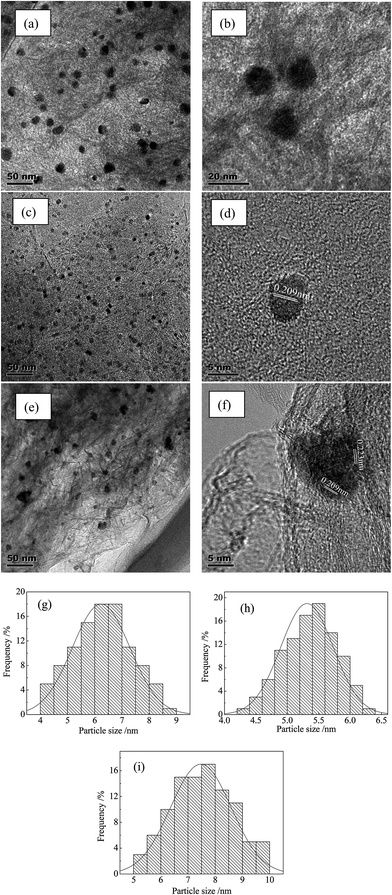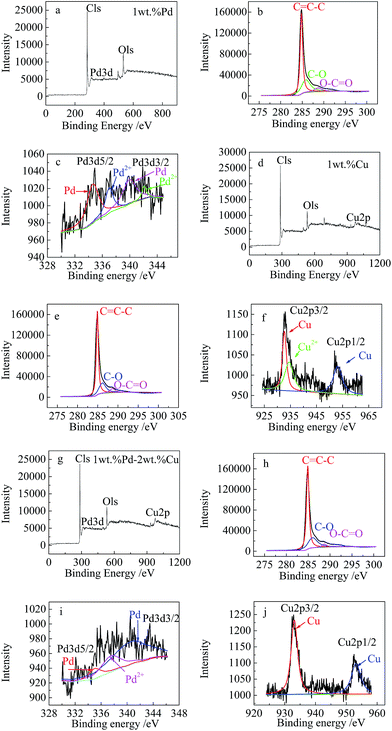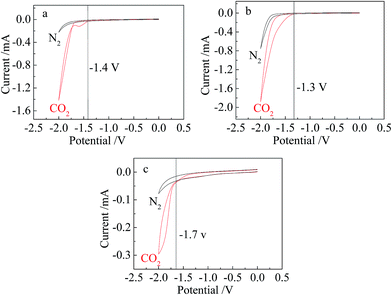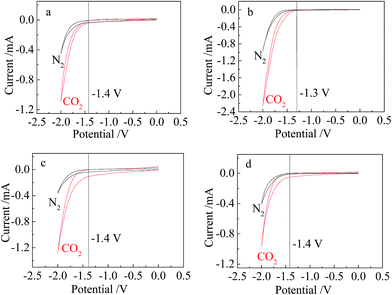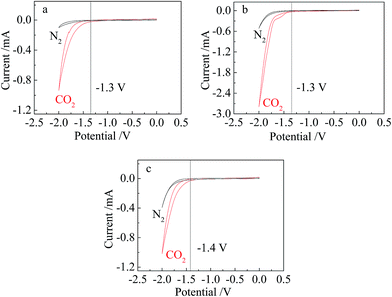Catalysis performance comparison for electrochemical reduction of CO2 on Pd–Cu/graphene catalyst†
Xin Liu‡
a,
Liangsheng Zhu‡a,
Hui Wang*a,
Guangya Hea and
Zhaoyong Bian*b
aCollege of Environmental Science and Engineering, Beijing Forestry University, Beijing 100083, PR China. E-mail: wanghui@bjfu.edu.cn; Fax: +86 10 62336596; Tel: +86 10 62336615
bCollege of Water Sciences, Beijing Normal University, Beijing, PR China. E-mail: bian@bnu.edu.cn; Fax: +86 10 58802739; Tel: +86 10 58802736
First published on 12th April 2016
Abstract
A Pd–Cu/graphene catalyst for the electrochemical reduction of CO2 was prepared by means of sodium borohydride reduction in a graphite oxide suspension with metal precursor salts, and characterized by X-ray diffraction (XRD), scanning electron microscopy (SEM), transmission electron microscopy (TEM), X-ray photoelectron spectroscopy (XPS), linear sweep voltammetry (LSV), cyclic voltammetry (CV), and current–time (I–t) scans technologies. The formation of Pd–Cu catalysts was investigated by changing the precursors and the Pd–Cu ratio. The results indicated that graphene with a d-spacing of 3.82 Å was fabricated and Pd–Cu metal nanoparticles whose size ranges from 8 to 10 nm were highly dispersed on the graphene sheets with amorphous structure. Additionally, sharp increase of the reduction current under CO2 compared to that under N2 could be observed which contributed to the catalytic reaction of CO2 reduction on the Pd–Cu/graphene electrode. The best catalytic performance of the metal/graphene catalysts was achieved on 1 wt% Pd–2 wt% Cu/graphene, which had a relative positive peak potential and reduction current were −1.3 V (vs. Ag/AgCl) and −2.8 mA, respectively. The Pd–Cu/graphene electrode effectively suppressed the reaction process of hydrogen and showed stable CO2 reduction activity. Finally, the reaction pathway for the CO2 reduction on the Pd–Cu/graphene electrode was proposed.
1. Introduction
The increasing emission of CO2 is an inevitable result of the world's energy consumption.1 CO2 is one of the important greenhouse gases that give rise to global warming, a serious threat to human survival. Therefore, reducing the amount of CO2 in the atmosphere has become a subject of growing attention, driven by the environmental pressures. More importantly, reducing the concentration of CO2 would be carried out to take advantage of renewable energy.2–4 To address these issues, the best approach is to reduce the release of CO2 from the combustion of fossil fuels and to convert CO2 to hydrocarbon fuels by a certain way, meanwhile.5 Recently, different methods have been carried out to convert CO2, such as chemical, thermochemical, photochemical, electrochemical, and biochemical procedures, the electrochemical method has been widely studied because of its unique advantages, such as mild reaction conditions, modular reaction system, and low content of by-products.5 However, there are still a lot of problems for electrochemical CO2 reduction. The electrochemical route shows a wide selectivity towards valuable products.6–11 The electrochemical reduction technology have to overcome the high oxidation reduction potential of the CO2/CO2− (−2.21 V vs. SCE).12 Furthermore, high overpotential, low selectivity, low solubility of CO2 are other key problems for electrochemical reduction of CO2.Many conductive materials have been preferably used as catalysts for electrochemical reduction of CO2. Metal and metal oxide electrodes appear to have been extensively studied, including Ag, Au, Pt, Cu, Pb, Hg, In, Pd and so on.13–19 Despite of the excellent conductive properties of metal, most metals themselves cost more highly than other materials. However, catalysts supported on nano-structured carbon materials, such as carbon black, carbon nanotubes, carbon nanofibers, graphene, has attracted much attention.20–23 As a 2D monolayer of sp2-hybridized carbon atoms, graphene has excellent electrical conductivity,24,25 large special surface area and high chemical stability, which would help promote electron transfer and improve reaction kinetics on noble metal nanoparticles.26–28 Furthermore, the reactive groups such as hydroxyl and carboxyl on graphene surface will provide coordination sites for the metal loaded.29 And the carbon vacancies in graphene can be used as anchoring points for the growth of metal nanoparticles.30 Besides, a significant electronic interaction between graphene and metal could be observed and graphene could enhance the activity and stability of the supported precious metals.24–26 Consequently, graphene has been widely used to support metal nanoparticles to prepare catalyst.27–31
In this paper, metal/graphene (Pd/graphene, Cu/graphene, Pd–Cu/graphene) catalysts were prepared and characterized by X-ray diffraction (XRD), scanning electron microscope (SEM), transmission electron microscopy (TEM), and X-ray photoelectron spectroscopy (XPS) technologies. The reduction performance of CO2 was investigated by electrochemistry tests to select stable and efficient metal/graphene catalyst. And the reduction mechanism was proposed for this system.
2. Experimental
2.1. Preparation of metal/graphene catalyst
Graphite oxide can be prepared by the improved Hummers method.32,33 At first, 1 mg graphite oxide was added into 100 mL of deionized water mixed aqueous solution conduct to ultrasonic to transparent solution. Copper acetate dissolved in the appropriate amount of deionized water can be added in graphene oxide solution, after that, regulating the mixture pH ≥ 10 for stirring for 2 h. Then moderate dilute hydrochloric acid solution (HCl–water mixture, 1![[thin space (1/6-em)]](https://www.rsc.org/images/entities/char_2009.gif) :
:![[thin space (1/6-em)]](https://www.rsc.org/images/entities/char_2009.gif) 50 v/v ratio) dissolved with palladium chloride 0.01 g were added into the above mixed to adjust pH ≥10. After regulating pH, make mixtures rapid stirring for 2 h reaction. After vigorously stirring for 2 h, excess sodium borohydride dissolved into pH ≥ 10 deionized water in ice bath. Then added it into graphene solution, which was also in ice bath. Excess sodium borohydride was used to reduce graphene oxide and metal ions to graphene and metal elements in the mixed solution, respectively. The Pd–Cu/graphene catalyst can be made-well by filtration, washing and vacuum drying after reacting 12 h under room temperature (25 °C). Refer to the above experimental procedures for preparing Pd/graphene (Cu/graphene) catalyst, no need adding another metal salts and operating the corresponding experimental steps. The amounts of experimental materials in specific experimental procedures are as shown in Table 1.
50 v/v ratio) dissolved with palladium chloride 0.01 g were added into the above mixed to adjust pH ≥10. After regulating pH, make mixtures rapid stirring for 2 h reaction. After vigorously stirring for 2 h, excess sodium borohydride dissolved into pH ≥ 10 deionized water in ice bath. Then added it into graphene solution, which was also in ice bath. Excess sodium borohydride was used to reduce graphene oxide and metal ions to graphene and metal elements in the mixed solution, respectively. The Pd–Cu/graphene catalyst can be made-well by filtration, washing and vacuum drying after reacting 12 h under room temperature (25 °C). Refer to the above experimental procedures for preparing Pd/graphene (Cu/graphene) catalyst, no need adding another metal salts and operating the corresponding experimental steps. The amounts of experimental materials in specific experimental procedures are as shown in Table 1.
| Metal/graphene | Graphite oxide (g) | PdCl2 (g) | Cu(CH3COO)2·H2O (g) |
|---|---|---|---|
| 0.5 wt% Pd | 0.1 | 0.005 | — |
| 1 wt% Pd | 0.1 | 0.01 | — |
| 3 wt% Pd | 0.1 | 0.015 | — |
| 0.5 wt% Cu | 0.1 | — | 0.0045 |
| 1 wt% Cu | 0.1 | — | 0.009 |
| 2 wt% Cu | 0.1 | — | 0.018 |
| 3 wt% Cu | 0.1 | — | 0.027 |
| 1 wt% Pd–1 wt% Cu | 0.1 | 0.005 | 0.09 |
| 1 wt% Pd–2 wt% Cu | 0.1 | 0.01 | 0.018 |
| 1 wt% Pd–3 wt% Cu | 0.1 | 0.015 | 0.027 |
2.2. Analytical methods
The XRD profiles of Cu/Pd-modified graphene were obtained (X'Pert PRO MPD, Holland) with a Rigaku D/max-III X-ray power diffractometer using high-intensity Cu Kα radiation (λ = 1.5406 nm) to discern the identity of any phase present and their crystallite size. SEM analysis was performed using scanning electron microscopy (Hitachi, S-4800, Tokyo, Japan) with a magnification of 100k and emission voltage of 10 kV. TEM image was taken with a JEM-2010 transmission electron microscope (JEOL Co., Ltd., Japan) operated at 200 kV for analyzing surface morphology and particle size of metal loaded on graphene surface. The surface composition of catalyst and Pd(Cu) surface concentration and valence state were then investigated by XPS (PHI5300, American) using the monochromatic Al Kα line. The binding energies were calibrated with respect to the C (1s) peak at 284.6 eV. The peak fit analysis was performed using the XPS PEAK program.2.3. Electrochemistry test
Electrochemical measurements were carried out on an electrochemical workstation (CHI660C, Chen Hua Instruments Co., Ltd., Shanghai, China) and data were analyzed with CHI software. A conventional three-electrode system was employed, involving a modified GC electrode as the working electrode, a platinum wire as the counter electrode, and an Ag/AgCl electrode as the reference respectively. GC electrode was polished with 1, 0.3, and 0.05 μm Al2O3 powder and then rinsed by ethanol and deionized water, dried under infrared lamp. 1.0 mg catalyst was dispersed in 5 μL 5 wt% Nafion solution and 1 mL of 99.5 wt% ethanol using high power ultrasonic for 30 min to form dispersed solution. A 10 μL portion of the resulting graphene dispersion was measured and then put over the glass carbon electrode. Finally, the graphene suspension was coated on the electrode, which was dried by infrared irradiation. Prior to electrochemical measurements, 0.5 mol L−1 KHCO3 solutions used as electrolytes in the cell were saturated with CO2 or N2 at an appropriate speed for 40 min, allowing adequate dissolution to occur. In CV sweeps, a scan rate of 400 mV s−1 was selected for a potential range in 0 to −2.0 V. For the time–current curve measurements, a constant potential of −1.50 V was imposed for 120 s where the resulting reduction current was recorded.3. Results and discussion
3.1. Metal/graphene catalyst characterization
The X-ray power diffraction spectra of Pd/graphene, Cu/graphene, and Pd–Cu/graphene catalysts are shown in Fig. 1. The average sizes of loaded metal nanoparticles on these samples were calculated using the Scherrer equation based on the XRD data and listed in Table S1.†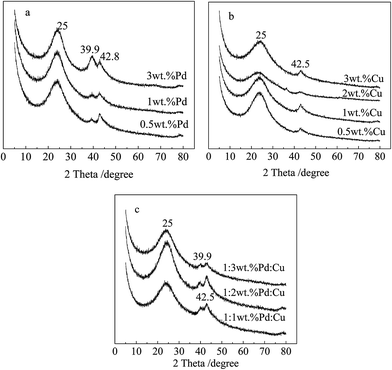 | ||
| Fig. 1 XRD pattern of (a) Pd/graphene catalysts, (b) Cu/graphene catalysts, and (c) Pd–Cu/graphene catalysts. | ||
As shown in Fig. 1a, the diffraction peaks at 25° and 42.8° in the diffraction pattern could be attributed to the hexagonal graphite structures (002) and (100), respectively. It indicated that the graphite oxide has been reduced to graphene. The graphene exhibited good electrical conductivity and could be good metal catalyst support material.34 The main characteristic diffraction peak of Pd particles in 0.5 wt% Pd/graphene, 1 wt% Pd/graphene, and 3 wt% Pd/graphene catalysts appeared at 39.9° which was corresponding to Pd(111) crystalline plane. The presence of Pd(111) facet indicated the successful reduction of metal salt to Pd(0).35 All the diffraction peaks position in the XRD pattern of Pd–Cu/graphene catalysts was same with that in the corresponding Pd/graphene catalysts or Cu/graphene catalysts. There was no significant peak change due to the alloy formation. Hence in present study, Pd and Cu did not form alloy.36 However, Pd particles in 0.5/1/3 wt% Pd/graphene samples exhibited as amorphous state because the XRD peak shape of Pd was so broad and the obvious crystal structure of palladium could not be found on the catalyst from the SEM. And the Pd particle size of 1 wt% Pd/graphene was smallest during three samples, which was consistent with the result calculated by Scherrer formula (Table S1†).
As shown in Fig. 1b, the diffraction peak attributed to the hexagonal graphite structures (002) located at 25° which indicated the reduction of graphite oxide. The characteristic diffraction peak appeared at 42.5° was attributed to (111) crystalline plane of Cu shown in Fig. 1b and c. Based on the XRD data, the Cu particle sizes in the catalyst samples with different copper content were calculated and summarized in Table S1.† In Fig. 1c, diffraction peaks at 40.2° (1 wt%), 39.7° (2 wt%), and 39.9° (3 wt%) in Pd–Cu/graphene samples were contributed to (111) crystalline plane of the face centered cubic (fcc) structure of the Pd. And the diffraction peaks at 42.5° were assigned to (111) crystalline plane of Cu. These observations indicated that metal salt had been converted to the palladium and copper nanoparticle successfully.
SEM characterization results of metal/graphene catalysts are shown in Fig. S1.† As clearly shown in Fig. S1,† the as-synthesized metal nanoparticles appeared as white spots, which were highly dispersed over the graphene surface. More metal particles on graphene surface could be observed with the increase of the loading palladium and copper content. The SEM images of three metal proportions of Pd–Cu/graphene (1 wt%–1 wt%, 1 wt%–2 wt%, 1 wt%–3 wt%) were shown in the Fig. S1h–j.† In these SEM figures, the metal particles were not only dispersed on the graphene well, but also shown larger particle size compared to that of the single metal catalyst.
TEM images, particle size distribution of metal/graphene catalysts (1 wt% Pd, 1 wt% Cu, and 1 wt% Pd![[thin space (1/6-em)]](https://www.rsc.org/images/entities/char_2009.gif) :
:![[thin space (1/6-em)]](https://www.rsc.org/images/entities/char_2009.gif) 2 wt% Cu) are shown in Fig. 2.
2 wt% Cu) are shown in Fig. 2.
As shown in Fig. 2a and g, Pd nanoparticles with a calculated diameter of 6.5 ± 0.25 nm were well-dispersed on the graphene. No obvious aggregation could be observed. According to Fig. 2c and h, Cu particle with a diameter of 5.4 ± 0.10 nm could be observed with highly dispersion on the graphene. As shown in Fig. 2d, the d spacing of adjacent lattice fringes of Cu in 1 wt% Cu/graphene catalyst was 0.209 nm, which matches well with Cu(111). TEM images of 1 wt% Pd![[thin space (1/6-em)]](https://www.rsc.org/images/entities/char_2009.gif) :
:![[thin space (1/6-em)]](https://www.rsc.org/images/entities/char_2009.gif) 2 wt% Cu/graphene were also provided in Fig. 2e and f. The average diameter size of metal nanoparticles loaded on graphene was 7.5 ± 0.25 nm. Similarly, from Fig. 2f, lattice fringes of Pd and Cu were clearly observed respectively in 1 wt% Pd
2 wt% Cu/graphene were also provided in Fig. 2e and f. The average diameter size of metal nanoparticles loaded on graphene was 7.5 ± 0.25 nm. Similarly, from Fig. 2f, lattice fringes of Pd and Cu were clearly observed respectively in 1 wt% Pd![[thin space (1/6-em)]](https://www.rsc.org/images/entities/char_2009.gif) :
:![[thin space (1/6-em)]](https://www.rsc.org/images/entities/char_2009.gif) 2 wt% Cu/graphene catalyst. The d spacing of adjacent lattice fringes were 0.209 nm and 0.223 nm which matched well with Cu(111) and Pd(111) planes, respectively. It indicated that Pd and Cu did not form an alloy, which was also proved by the XRD patterns. The particle size of metal particles was larger compared with the single metal loaded on graphene due to the two metal nanoparticle combination.
2 wt% Cu/graphene catalyst. The d spacing of adjacent lattice fringes were 0.209 nm and 0.223 nm which matched well with Cu(111) and Pd(111) planes, respectively. It indicated that Pd and Cu did not form an alloy, which was also proved by the XRD patterns. The particle size of metal particles was larger compared with the single metal loaded on graphene due to the two metal nanoparticle combination.
To investigate element content in the graphene catalysts loaded with Pd and Cu nanoparticles, XPS was carried out and results are shown in Fig. 3. XPS spectra of all the catalysts were fitted.
As shown in Fig. 3a, d, and g, the peaks assigned to the elements of Pd, C, and O (Cu, C, and O; Pd, Cu, C, and O) indicated the designed metal loaded graphene catalysts were prepared. In order to check the oxidation state of graphene samples, and in particular that of the external faces of the sample, high resolution C 1s XPS spectra were collected from metal/graphene catalysts (Fig. 3b, e, and h). Three peaks at 284.6, 285.8, and 288.7 eV appeared in the C 1s spectra, which were attributed to graphitic sp2 carbon (C![[double bond, length as m-dash]](https://www.rsc.org/images/entities/char_e001.gif) C/C–C), carbonyl (C–O), and carboxyl (O–C
C/C–C), carbonyl (C–O), and carboxyl (O–C![[double bond, length as m-dash]](https://www.rsc.org/images/entities/char_e001.gif) O) functional groups, respectively.21 The relative content of graphitic carbon in the sample was estimated to be 60.1%, 65.5%, and 65.8% in 1 wt% Pd/graphene, 1 wt% Cu/graphene, and 1 wt% Pd–2 wt% Cu/graphene samples, which were much higher than 41.9% of GO. Substantial amount of deoxidation of graphitic sp2 carbon (C
O) functional groups, respectively.21 The relative content of graphitic carbon in the sample was estimated to be 60.1%, 65.5%, and 65.8% in 1 wt% Pd/graphene, 1 wt% Cu/graphene, and 1 wt% Pd–2 wt% Cu/graphene samples, which were much higher than 41.9% of GO. Substantial amount of deoxidation of graphitic sp2 carbon (C![[double bond, length as m-dash]](https://www.rsc.org/images/entities/char_e001.gif) C/C–C) contributed to the formation of graphene composites.21 Additionally, in the presence of Pd and Cu metal nanoparticles, the XPS data shown in Fig. 3a, d, and g indicated that not all the oxygen containing groups in GO have been reduced, which was in agreement with the C 1s XPS spectra. The partial reduction of GO could be explained by a competition between the metal ions and GO and the coordination between oxygen containing groups and metal ions.
C/C–C) contributed to the formation of graphene composites.21 Additionally, in the presence of Pd and Cu metal nanoparticles, the XPS data shown in Fig. 3a, d, and g indicated that not all the oxygen containing groups in GO have been reduced, which was in agreement with the C 1s XPS spectra. The partial reduction of GO could be explained by a competition between the metal ions and GO and the coordination between oxygen containing groups and metal ions.
The XPS data of the Pd 3d electron binding energy in the 1% wt Pd/graphene catalyst, shown in Fig. 3c, indicated that 78% of precursor metal salt PdCl2 had been reduced to Pd(0) consistent with the observed binding energies of 335 eV (Pd(0)3d5/2) and 340.2 eV (Pd(0)3d3/2). Reduction degree of Pd(2+) can be calculated according to the following formula (1) below.
 | (1) |
The peaks occurred at 337.6 eV and 342.2 eV were corresponding to Pd(2+) (PdCl2). Similarly, from Fig. 3i, the reduction degree of PdCl2 could reach 77% and the remaining Pd(2+) (PdCl2) XPS peak emerged at 337.6 eV. However, Pd peak was not obvious but the pulse was apparent, which was due to the low amount of Pd loading (only 1 wt%) and limited to the XPS sensitivity.
The high resolution Cu 2p XPS spectrum (Fig. 3f) exhibited binding energies at 952.56 eV and 932.70 eV that could be assigned to Cu 2p1/2 and Cu 2p3/2 of Cu. The peak at 933.9 eV could be attributed to CuO. It further illustrated that 67% precursor copper acetate was reduced to monatomic Cu loaded on graphene surface. Similarly, from the Fig. 3j, both peaks at 952.56 eV and 932.70 eV could be attributed to Cu 2p1/2 and Cu 2p3/2 of Cu. Some weak satellite peaks emerged around 943 eV could be attributed to CuO. The reduction degree of precursor copper acetate reached 90%.
3.2. Electrochemistry test
In order to study the catalytic effects of electrochemical reduction of CO2 and their reduction stabilities, cyclic voltammetry and current–time curves scans were performed on these prepared catalyst samples. Fig. 4–6 shows CV scans at metal/graphene catalysts coated glassy carbon electrode under 1 atm N2 or CO2 saturated 0.5 mol L−1 KHCO3. The CV of metal/graphene peak potentials and currents were summarized in the following Table 2. The reducing current under CO2 increased significantly when a relative positive potential was applied, which could be assigned to the catalytic reaction of CO2 reduction. Comparing the reducing currents under CO2 and N2 atmosphere, the catalytic effect for the CO2 reduction could be evaluated.| Metal/graphene (wt%) | Peak potential (V) | Current (mA) | ||
|---|---|---|---|---|
| CO2 | N2 | CO2 | N2 | |
| 0.5% Pd | −1.4 | −1.75 | −1.42 | −0.2 |
| 1% Pd | −1.3 | −1.75 | −1.88 | −0.7 |
| 3% Pd | −1.7 | −1.75 | −0.30 | −0.075 |
| 0.5% Cu | −1.4 | −1.75 | −1.09 | −0.44 |
| 1% Cu | −1.3 | −1.75 | −2.25 | −0.9 |
| 2% Cu | −1.4 | −1.75 | −1.28 | −0.38 |
| 3% Cu | −1.4 | −1.75 | −0.97 | −0.4 |
| 1% Pd–1% Cu | −1.3 | −1.75 | −0.94 | −0.1 |
| 1% Pd–2% Cu | −1.3 | −1.75 | −2.80 | −0.5 |
| 1% Pd–3% Cu | −1.4 | −1.75 | −1.02 | −0.4 |
The CV behavior shown in Fig. 4 provided obvious evidence of catalytic CO2 reduction at electrodeposited Pd/graphene catalysts in solutions saturated with CO2. It could be seen that reduction current increased significantly at −1.4 V (peak potential) in the solution saturated with CO2 compared with solution saturated with N2 for 0.5 wt% Pd/graphene catalyst (Fig. 4a). Its current value increased to −1.42 mA at −2.0 V, which was much larger than the peak current value of N2 solution (−0.2 mA). In the same way, the reduction current of 1 wt% Pd/graphene catalyst and 3 wt% Pd/graphene catalyst reached −1.88 mA and −0.30 mA at −2.0 V, respectively. In addition, the peak potential of 1 wt% Pd/graphene catalyst and 3 wt% Pd/graphene catalyst were −1.3 V (vs. Ag/AgCl) and −1.7 V (vs. Ag/AgCl), respectively. It indicated that the overpotential of CO2 reduction was smallest when the metal palladium load was 1%.
From Table 2, the overpotential of CO2 reduction was smallest when the 1% loading content was applied for the copper loaded samples. However, the peak potential of 1 wt% Pd–2 wt% Cu/graphene (−1.3 V) was most positive in all bimetallic catalyst samples. Comparing the current difference under CO2 and N2 at −2.0 V, the pure catalytic current under the potential could be achieved. The catalytic current decreased in the following order: 1% Pd > 0.5% Pd > 3% Pd (1.88 mA > 1.42 mA > 0.30 mA); 1% Cu > 2% Cu > 0.5% Cu > 3% Cu (2.25 mA > 1.28 mA > 1.09 mA > 0.97 mA); 1% Pd–2% Cu > 1% Pd–3% Cu > 1% Pd–1% Cu (2.8 mA > 1.02 mA > 0.94 mA). Comprehensive analysis of the peak potential and catalytic reduction current provided important information for the evaluation of the catalyst activity for the CO2 reduction. For Pd(Cu), the 1 wt% Pd (2 wt% Cu) have the best catalytic effect, and the 1% Pd–2% Cu/graphene was also the most efficient catalyst in all prepared bimetallic catalysts.
As the potential moving negatively, reduction current value of metal/graphene catalysts increased and the maximum value reached −2.80 mA for 1 wt% Pd–2 wt% Cu/graphene catalyst sample. It indicated that 1 wt% Pd–2 wt% Cu/graphene catalyst exhibited better catalytic performance compared to the 1 wt% Pd/graphene and 1 wt% Cu/graphene under the same operation conditions. Electrochemical reduction capacity of 1 wt% Pd–2 wt% Cu/graphene was further enhanced in which Pd–Cu bimetallic loading on the graphene together with an appropriate proportion could make contribute to reduction of CO2. The enhanced catalytic performance of the bimetallic catalyst was certainly related with its structure. According to the microscopic structure of the catalyst, there were several possible reasons. Firstly, compared to monometallic catalyst, the content of graphitic carbon in bimetallic catalyst increased, which probably led to enhance the conductive property of bimetallic catalyst. Second, the reduction degree of Cu in 1 wt% Pd–2 wt% Cu/graphene catalyst was much higher than that of 1 wt% Cu/graphene catalyst. Pd could act as a catalyst for the reduction of Cu. In addition, from the HRTEM of 1 wt% Pd/graphene, and 1 wt% Pd![[thin space (1/6-em)]](https://www.rsc.org/images/entities/char_2009.gif) :
:![[thin space (1/6-em)]](https://www.rsc.org/images/entities/char_2009.gif) 2 wt% Cu/graphene catalysts, the crystallization of metallic palladium became better.
2 wt% Cu/graphene catalysts, the crystallization of metallic palladium became better.
Fig. 7–9 shows I–t curve test at metal/graphene catalyst coated glassy carbon electrode under 1 atm N2 and CO2 saturated 0.5 mol L−1 KHCO3, respectively.
As shown in Fig. 7, the reduction current decayed dramatically during the first 5 s and then kept stable. Compared to the other samples, 1 wt% Pd/graphene catalyst exhibited better stability. Similarly, the results shown in Fig. 8 exhibited that 1 wt% Cu/graphene catalyst had good stability compared to other Cu/graphene catalysts. Comparison of Pd–Cu/graphene catalysts' I–t scans in Fig. 9, 1 wt% Pd–2 wt% Cu/graphene catalyst showed the most stable catalytic effect on CO2 catalytic reduction.
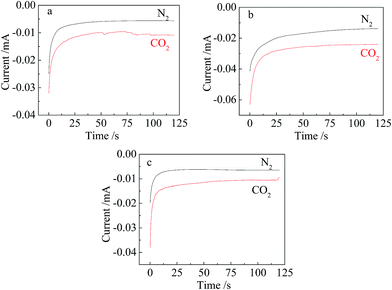 | ||
| Fig. 7 I–t curves scans of (a) 0.5 wt%, (b) 1 wt%, and (c) 3 wt% Pd/graphene catalysts at −1.5 V with 120 s. | ||
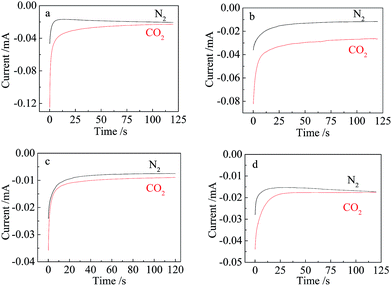 | ||
| Fig. 8 I–t curves scans of (a) 0.5 wt%, (b) 1 wt%, (c) 2 wt%, and (d) 3 wt% Cu/graphene catalysts at −1.5 V with 120 s. | ||
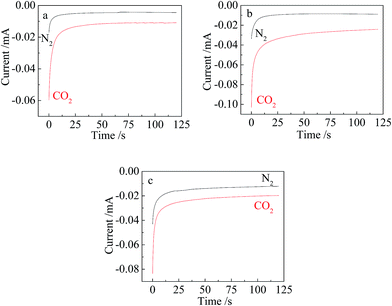 | ||
| Fig. 9 I–t curves scans of (a) 1 wt% Pd–1 wt% Cu/graphene catalyst, (b) 1 wt% Pd–2 wt% Cu/graphene catalyst, and (c) 1 wt% Pd–3 wt% Cu catalyst at −1.5 V with 120 s. | ||
Fig. S2a and b† shows reductive LSV scans at Pd–Cu/graphene catalyst in different concentrated CO2 saturated KHCO3 and the fitting of the reduction current at −1.5 V. Concentration of KHCO3 was regarded as X, reduction current was regarded as Y. The relationship of the Y and X was described as Fig S2b.† And then, formula (2)
| Y = aX + b = −0.00313X − 1.40694 | (2) |
| CO2 (solution) → CO2 (ads) | (3) |
| CO2 (ads) + e− → CO2·− (ads) | (4) |
| CO2·− (ads) + HCO3− + e− → HCO2− (ads) + CO32− | (5) |
| HCO2− (ads) → HCO2− (solution) | (6) |
| CO32− + CO2 + H2O → 2HCO3− | (7) |
4. Conclusions
Pd and Cu mono- and bi-metal nanoparticles loaded graphene catalyst were prepared using co-reduction methods. The metal particles were uniformly dispersed on the graphene surface which was supported by the data of SEM, TEM, and XPS. And metal nanoparticle sizes of 1 wt% Pd/graphene, 1 wt% Cu/graphene, and 1 wt% Pd–2 wt% Cu/graphene supported catalysts were 6.5 ± 0.25 nm, 5.4 ± 0.10 nm, and 7.5 ± 0.25 nm, respectively. The electrocatalytic performance test results showed that the prepared catalysts had catalytic effects for the reduction of CO2 in CO2 saturated KHCO3 solution. Comparison of the mono- and bi-metal nanoparticles loaded samples, the best catalytic activity for the CO2 reduction was achieved from 1 wt% Pd–2 wt% Cu/graphene catalyst, in which the overpotential for the CO2 reduction was smallest and catalytic current was biggest. The pathway for the CO2 reduction on the prepared catalysts was proposed.Acknowledgements
This work was supported by the Fundamental Research Funds for the Central Universities (No. 2015ZCQ-HJ-02), the National Natural Science Foundation of China (No. 51278053 and 21373032).References
- S. Gao, Y. Lin, X. C. Jiao, Y. F. Sun, Q. Q. Luo, W. H. Zhang, D. Q. Li, J. L. Yang and Y. Xie, Nature, 2016, 529, 68–71 CrossRef CAS PubMed.
- Q. J. Feng, S. Q. Liu and G. H. Jin, Appl. Surf. Sci., 2012, 258, 5005–5009 CrossRef CAS.
- D. Mignard, M. Sahibzada, J. M. Duthie and H. W. Whittington, Int. J. Hydrogen Energy, 2003, 28, 455–464 CrossRef CAS.
- X. C. Kang, Q. G. Zhu, X. F. Sun, J. Y. Hu, J. L. Zhang, Z. M. Liu and B. X. Han, Chem. Sci., 2016, 7, 266–273 RSC.
- G. B. Stevens, T. Reda and B. Raguse, J. Electroanal. Chem., 2002, 526, 125–133 CrossRef CAS.
- A. F. Pérez-Cadenas, C. H. Ros, S. Morales-Torres, M. Pérez-Cadenas, P. J. Kooyman, C. Moreno-Castilla and F. Kapteijn, Carbon, 2013, 56, 324–331 CrossRef.
- V. Tripkovic, M. Vanin, M. Karamad, M. E. Björketun, K. W. Jacobsen, K. S. Thygesen and J. Rossmeisl, J. Phys. Chem. C, 2013, 117, 9187–9195 CAS.
- S. Kaneco, K. Iiba, M. Yabuuchi, N. Nishio, H. Ohnishi, H. Katsumata, T. Suzuki and K. Ohta, Ind. Eng. Chem. Res., 2002, 41, 5165–5170 CrossRef CAS.
- B. Innocent, D. Liaigre, D. Pasquier, F. Ropital, J. M. Léger and K. B. Kokoh, J. Appl. Electrochem., 2009, 39, 227–232 CrossRef CAS.
- Y. Hori, I. Takahashi, O. Koga and N. Hoshi, J. Phys. Chem. B, 2002, 106, 15–17 CrossRef CAS.
- J. Yano, T. Morita, K. Shimano, Y. Nagami and S. Yamasaki, J. Solid State Electrochem., 2007, 11, 554–557 CrossRef CAS.
- A. Rodes, E. Pastor and T. Iwasita, J. Electroanal. Chem., 1994, 376, 109–118 CrossRef CAS.
- Y. C. Lan, H. Wang, L. X. Wu, S. F. Zhao, Y. Q. Gu and J. X. Lu, J. Electroanal. Chem., 2012, 664, 33–38 CrossRef CAS.
- T. Ohmori, A. Nakayama, H. Mametsuka and E. Suzuki, J. Electroanal. Chem., 2001, 514, 51–55 CrossRef CAS.
- M. Z. Ertem, S. J. Konezny, C. M. Araujo and V. S. Batista, J. Phys. Chem. Lett., 2013, 4, 745–748 CrossRef CAS PubMed.
- W. Tang, A. A. Peterson, A. S. Varela, Z. P. Jovanov and L. Bech, Phys. Chem. Chem. Phys., 2012, 14, 76–81 RSC.
- W. J. Durand, S. Dahl, J. K. Nørskov and I. Chorkendorff, Phys. Chem. Chem. Phys., 2012, 14, 76–81 RSC.
- M. Todoroki, K. Hara, A. Kudo and T. Sakata, J. Electroanal. Chem., 1995, 394, 199–203 CrossRef.
- C. Iwakura, S. Takezawa and H. Inoue, J. Electroanal. Chem., 1998, 459, 167–169 CrossRef CAS.
- T. Yamamoto, D. A. Tryk, K. Hashimoto, A. Fujishima and M. Okawa, J. Electrochem. Soc., 2000, 147, 3393–3400 CrossRef CAS.
- T. Y. Chang, R. M. Liang, P. W. Wu, J. Y. Chen and Y. C. Hsieh, Mater. Lett., 2009, 63, 1001–1003 CrossRef CAS.
- R. Zhang, W. X. Lv, G. H. Li and L. X. Lei, Mater. Lett., 2015, 141, 63–66 CrossRef CAS.
- R. Kou and Y. Y. Shao, J. Am. Chem. Soc., 2011, 133, 2541–2547 CrossRef CAS PubMed.
- S. Zhang, P. Kang and T. J. Meyer, J. Am. Chem. Soc., 2014, 136, 1734–1737 CrossRef CAS PubMed.
- Y. L. Zheng, S. L. Zhao, S. L. Liu, H. H. Yin, Y. Y. Chen, J. C. Bao, M. Han and Z. H. Dai, ACS Appl. Mater. Interfaces, 2015, 7, 5347–5357 CAS.
- C. X. Xiao, T. W. Goh, Z. Y. Qi, S. Goes, K. Brashler, C. Perez and W. Huang, ACS Catal., 2016, 6, 593–599 CrossRef CAS.
- D. H. Galvan, A. P. Amarillas, R. Núñez-González, S. Mejía and M. José-Yacamán, J. Supercond. Novel Magn., 2010, 23, 1543–1550 CrossRef CAS.
- E. H. Song, Z. Wen and Q. Jiang, J. Phys. Chem. C, 2011, 115, 3678–3683 CAS.
- S. Moussa, V. Abdelsayed and M. S. El-Shall, Chem. Phys. Lett., 2011, 510, 179–184 CrossRef CAS.
- T. S. Koltsova, L. L. Nasibulina, I. V. Anoshkin, V. V. Mishin, E. I. Kauppinen, O. V. Tolochko and A. G. Nasibulin, J. Mater. Sci. Eng., 2012, 4, 240–246 Search PubMed.
- S. Pérez-Rodríguez, N. Rillo, M. J. Lázaro and E. Pastor, Appl. Catal., B, 2015, 163, 83–95 CrossRef.
- N. I. Kovtyukhova, P. J. Ollivier, B. R. Martin, T. E. Mallouk, S. A. Chizhik, E. V. Buzaneva and A. D. Gorchinskiy, Chem. Mater., 1999, 11, 771–778 CrossRef CAS.
- W. S. Hummers and R. E. Offeman, J. Am. Chem. Soc., 1958, 80, 1339 CrossRef CAS.
- K. Zhang, L. L. Zhang, X. S. Zhao and J. S. Wu, Chem. Mater., 2010, 22, 1392–1401 CrossRef CAS.
- Y. C. Zhao, L. Zhan, J. N. Tian, S. L. Nie and Z. Ning, Electrochim. Acta, 2011, 56, 1967–1972 CrossRef CAS.
- Y. Kim, D. H. Wi, S. Lee, S. Lee, Y. W. Lee, S. Choi and S. W. Han, Angew. Chem., Int. Ed., 2016, 128, 2803–2808 CrossRef.
Footnotes |
| † Electronic supplementary information (ESI) available. See DOI: 10.1039/c6ra03160a |
| ‡ These authors contributed equally to this work and should be considered co-first authors. |
| This journal is © The Royal Society of Chemistry 2016 |

